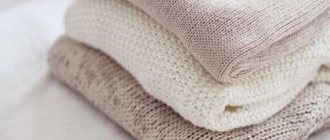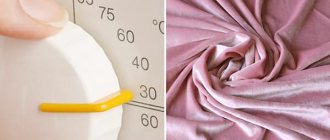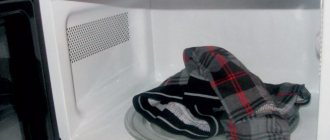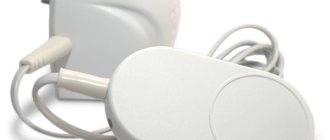Modern housewives can quickly wash them in a washing machine. Despite its simplicity, the process also has its own washing rules. To ensure that things last longer, do not wash out, do not fade, and remain in their original shape, you need to pay attention to some tips for this almost daily activity. Because the quality of washing depends not only on the washing machine.
Can towels be washed with clothes?
In addition to color, you also need to pay attention to the type of fabric: fleece clothing is washed only separately, and towels are never washed together with synthetic items. Improper stain removal. ... Stains need to be washed out carefully. And it’s better not to rub, but to blot the stain with a piece of white cloth.
Interesting materials:
What is the correct way to be a manicurist or manicurist? How to properly wash a white shirt? How to properly wash boxing gloves? How to properly wash your hair after coloring? How to properly clean tiled floors? How to properly wash PVC windows? How to properly wash painted walls? How to properly wash rattles? How to properly wash a mirror? How to start a dialogue with a girl on the Internet?
Preparation
If clothes are stored in a basket before washing, then it should be noted that it must have holes so that air can flow to the clothes. Otherwise, stains from dampness may appear, and they are difficult to wash.
Preparing for washing is an important process on which the final result depends. You need to check all pockets so that no money or documents get into the machine. The jacket should be zipped, but the buttons, on the contrary, should be left undone. Deploy all “tackles”. If there are loose metal objects, such as a belt, they should be removed. Bed linen, stockings, socks, knitted and terry products are loaded into the machine inside out. It is recommended to wash small items of clothing in a special bag.
To wash clothes correctly, you need to study the signs depicted on the clothes. Manufacturers often put an icon of a basin with water and a lowered hand on the label. This means that you need to wash it by hand. Companies insure against possible defects or deformation during mechanical washing. Sometimes, before putting the laundry into the machine, you still need to do some manual work. For example, if the stain is old, it should be treated or soaked in a special solution before washing.
Is it necessary to wash new bed linen?
Many housewives are wondering whether they need to wash new bed linen or whether they can use it right away. Newly purchased items look so good that you don’t want to wash them. But this impression is deceptive.
In fact, during the production process, fabric is picked up by people, dust settles on it, and it passes through various equipment. So washing new clothes is necessary . For the first wash, you should choose the highest permissible temperature in order to disinfect the laundry, get rid of the specific smell of new fabric and remove dye residues.
New linen should be put on the bed only after washing.
So, you need to wash your bed linen in the machine at least once a week. To select the correct wash cycle, check the manufacturer's care instructions label.
At what temperature is it safe to wash?
The symbols on the label will help you choose the correct automatic washing parameters.
The label on the clothing will help you choose the right washing program. It contains information about the necessary conditions. But if for some reason there is no tag or there is no access to information, there are general recommendations that should be followed when choosing a mode. They will help prolong the neat appearance of your clothes by choosing the optimal temperature and spin speed. How to wash correctly is shown in the table:
| Type of clothing or fabric | Washing temperature, degrees | Spin speed, revolutions/min. |
| Shedding things | Not higher than 30 | No more than 400 |
| Silk or wool | < 40 | up to 600 |
| Artificial fabrics | < 50 | 800—900 |
| Colored cotton | < 60 | above 800—1000 |
| Natural cotton and linen, especially light shades | up to 95 |
Detergents
Depending on the composition of the product and the type of fabric of the product, household chemicals are selected.
Different fabrics require different detergents, the choice of which must take into account the etiology of contamination. White linen should be washed with two types of powders. White plain items can be washed with bleaching powder, and if items of clothing have stripes or large patterns, it is better to use a detergent for colored items.
To preserve the quality of wool and synthetic items, it is better to wash them with a liquid product rather than a regular detergent. Items of deep black color should be washed with a special product for black fabrics, otherwise streaks may remain. Be sure to use bleach when removing stains from tea, coffee, wine, and vegetables. When exposed to it, the dirt oxidizes and breaks down. The enzymes contained in many modern powders are suitable for cleaning things from protein contaminants. These biological catalysts can help remove stains from starch, cocoa, eggs, and blood.
Wool
Rossella/Shutterstock.com
How to wash
Clothes made of wool are difficult to care for: if you wash your favorite sweater in too hot water, it will shrink by several sizes, and you won’t be able to restore its original appearance. For some items, washing is completely contraindicated - for example, it is better to dry-clean a cashmere jacket, otherwise you can say goodbye to it right away.
Woolen clothes should be washed on a delicate cycle so that the water temperature does not exceed 30 °C. You can spin such things in the machine only at minimum speed.
For washing, do not use powder, but special delicate products: they will carefully remove dirt and soften the fibers so that the clothes do not prick. In a pinch, a mild shampoo will do, but then you will have to add an extra rinse cycle.
How to dry
After washing, do not twist woolen clothes by hand: rough handling will cause them to lose their shape. To remove excess water, place the sweater on a clean terry towel, roll it up and roll it. The towel will absorb water, and the sweater will dry faster after this procedure.
To prevent wool items from stretching, dry them on a horizontal surface. You can use a tumble dryer, but make sure it has the appropriate setting. If the image of a dryer is crossed out on a clothing label, it is better not to take risks: the item may become covered with pills or shrink in size. Wool absorbs odors perfectly, so things should dry in a well-ventilated area away from the kitchen.
It is better to iron at a minimum temperature, turning the clothes inside out. To prevent shiny marks from appearing on the fabric, it should be ironed through damp gauze, carefully applying the iron.
How to bleach cotton items?
Only light-colored items can be subjected to this procedure at home; dark fabrics should not be bleached. Gray or yellowed fabrics are soaked without sewing in one of the following solutions (which one to choose for the procedure is up to you):
- 2 tbsp. l. salt per 10 liters of water;
- 2 tbsp. l. ammonia and 2 tbsp. l. hydrogen peroxide per 10 liters of water.
The finished processing time will be 15-30 minutes. To disinfect grayed laundry, boil it for half an hour in 10 liters of water with a grated coarse bar of laundry soap, 1 tbsp. l. ammonia, 2 tbsp. l. salt and soda, 3 tbsp. l. washing powder and 2 tbsp. l. "Whiteness." This method is not suitable for large winter knitted items - pills will form.
How to dry and iron cotton correctly?
Leave light cotton curtains in a basin to drain water, then dry them directly on the curtain rod. Hang jeans and men's trousers on a line to dry; coats, jackets and shirts on hangers. Lace underwear, soft knitwear, kimonos, sweaters, T-shirts, T-shirts, bathrobes, jackets, dresses and Indian items with acrylic embroidery, dry batik on the table, bed linen, sheets, mattress covers without filler, pillows, pullovers, down jackets, new blankets with insulation, towels and tablecloths - on the dryer. Do not expose 100% white cotton, mercerized organic polyester rug to direct sunlight. Why? Because these items will turn yellow from the sun.
Features of ironing: iron cotton products in a slightly damp state, spray with water to avoid streaks. Do not iron terry towels; to restore the softness of their pile, place them in the freezer for several hours.
How to properly wash suede or fabric shoes
What mode should you use to wash shoes in a washing machine? Not only sneakers are washed in this way, but also shoes made of suede or those with a fabric surface, for example, slippers. First, shoes should be washed, especially the soles, and remove laces or decorative parts if they are removable. The shoes are placed in the drum of the machine and set to the Delicate wash mode.
Some new models of these household appliances already have a special program called Shoe Washing. It provides a hint on what mode to wash your sneakers in the machine.
How to properly load clothes into a washing machine
Do not store dirty laundry in the washing machine. Harmful microorganisms may grow in the drum.
Distribute the items evenly throughout the drum. Do not add more laundry than stated in the instructions. If you fill the machine too much, the clothes will not wash well. Cotton and linen clothes pass water well, so the drum can be completely filled with it.
When washing sportswear and other items made from synthetic fabrics, fill the drum no more than halfway. Synthetics do not absorb moisture well. To wash it, you will need more water.
When washing delicate items made of silk and wool, it is better to fill the drum only one-third full. This way the clothes will float freely in the water and the walls of the drum will not injure them.
Cotton
Brian A Jackson / Shutterstock.com
How to wash
Products made from thick cotton fabric can be washed at temperatures up to 95 °C, but it is better to experiment with hot water less often, otherwise the fibers of the fabric will quickly break down and a hole will appear on your favorite shirt.
White items can be washed at temperatures up to 65 °C; for colored items, temperatures between 30 and 40 °C are suitable (clothes may fade when washed in hot water). The optimal spin mode is up to 800 rpm. Wash colored and white items separately. Before putting your clothes in the machine, check to see if they are fading. Wet a corner or inner seam of the product with soapy water and run a dry cotton pad over it. If a distinct color mark remains on it, it is better to wash this item by hand.
Before washing, soak stained clothes in warm water with added stain remover. It is better not to soak colored items for a long time, otherwise the fabric will lose its brightness.
How to dry
After washing, shake clothes to remove wrinkles and hang them on a clothes line or drying rack. Thick cotton items can be put in the dryer: this will make your favorite terry robe soft even without conditioner.
Cotton knits should dry on a flat surface, such as a clothes dryer covered with a towel. Hanging a wet cotton sweater on a line can cause it to stretch and lose its shape.
Do not over-dry cotton clothes, otherwise you will have trouble ironing out creases in the fabric. If the item still takes too long to dry, spray it with water before ironing. Cotton can be ironed at high temperature with steam.
To make things dry faster and softer, you can get a drying machine. You simply load the laundry into the drum and take it out warm and dry. Such devices do not take up much space: the Italian brand Candy has a narrow model that easily fits into cramped closets, closets or small bathrooms. It can even be installed directly on the washing machine.
Candy dryers are equipped with a special reservoir to collect water, so they do not need to be connected to a drain. If you wash and dry things every day, you don’t have to worry about bills: the device runs on a heat pump and uses energy sparingly.
To learn more
How to wash by hand?
It is advisable to manually erase oil traces from gasoline and kerosene: these substances have a bad effect on the components of the machine. It is also recommended to hand wash leather goods or substitute clothing because they may become deformed or fade. Hand washing should be done in a convenient place. To do this you will need:
It is important to use hand protection during manual handling.
- two basins;
- hand washing powder or detergent;
- rinse aid;
- rubber gloves.
Laundry soap is perfect for delicate fabrics, such as underwear. Before washing, you should soak things for 15-20 minutes, if very dirty, then for 2-3 hours, and bed linen - overnight. The water temperature is selected according to the type of fabric, but should not exceed 50 degrees. It is better to look at the product tag for information about the necessary conditions. If it is not there, you should use the general rules. The correct water temperature will help preserve the product longer. The basic rules are shown in the table:
| Fabric type | Water temperature, degrees |
| Linen, cotton | up to 95 |
| Delicate fabrics: silk and wool | 30—40 |
| Synthetics | 40—50 |
Despite the fact that the procedure is technically simple, washing things by hand is physically difficult. To begin, add powder or gel to a bowl of water and shake the foam. Pre-soaked clothes are dangled in a basin, then rubbed where the most contaminated places are to wash them. For convenience, you can use a washboard. It will not only help you wash things clean, but will also make this process easier. After washing, it is recommended to rinse the items twice: the first will wash away the soap solution, the second will refresh the clothes.
Which washing mode to choose
It's better to focus on the name. To wash bed linen and towels in the washing machine, select the “cotton” mode. For delicate items and wool, “delicate” or “hand wash” is suitable. For T-shirts, socks and underwear that are not too dirty, you can use the "daily wash". To refresh your item, run a quick wash.
Do not use the prewash and extra rinse functions unless necessary - this will save water and energy.
If someone in the house is sick, wash their clothes at the maximum temperature allowed by the instructions on the label. It is also recommended to wash kitchen textiles, towels, bed linen and panties at a temperature of at least 60 degrees.
Frequency of bed linen change
Many people still don't know how often to wash their bedding. They believe this: if there are no obvious signs of contamination that are visible to the naked eye, then the laundry is clean. Therefore, they wash it once every 2-3 weeks . In fact, this is wrong. Sheets and duvet covers get dirty quickly, so they must be replaced and washed at least once a week.
With pillowcases the situation is worse. They immediately absorb hair oil, night creams and other cosmetics used for hair and facial skin. After 2-3 days, the pillowcase should be changed and washed.
Linen
How to wash
Undyed linen can be washed at temperatures up to 90°C, while colored items are suitable for cooler water – 30–40°C. Such things can withstand spinning at 600 rpm, but you shouldn’t twist them by hand: you can overdo it and stretch or tear the fabric.
Chlorine bleaches are not suitable for linen. If you need to remove a stubborn stain, use oxygen products. Soak your clothes with them before washing and set the extra rinse mode.
If there is embroidery on a linen item, it is better not to take risks and wash such a product by hand so that it does not fade. You cannot soak the area with the pattern for a long time and vigorously rub it, as you will only ruin the clothes.











